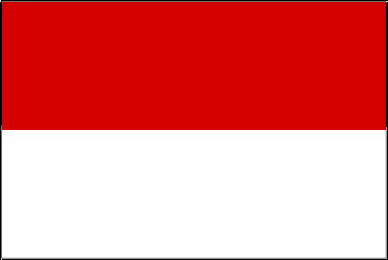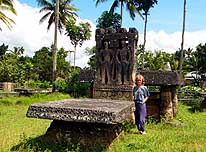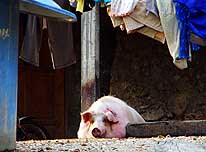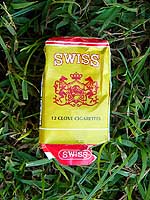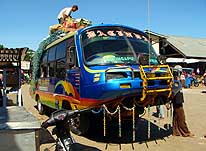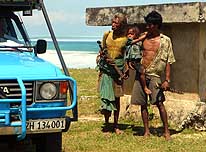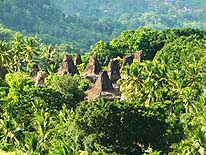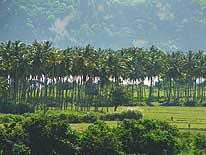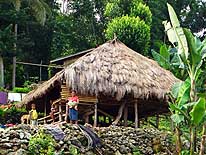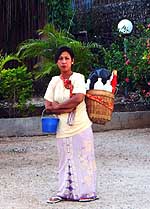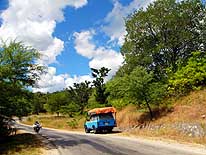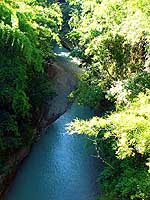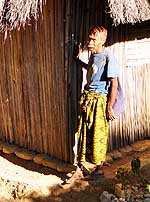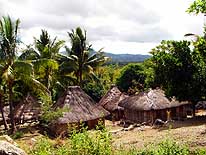latest picture: June 5, 2007
- click a picture to see details
|
- More websites from Indonesia and Timor-Leste:
|
-
- On November 21st, 2006, we left the Island of Borneo
after half a year, where we overhauled completely
our car and visited the Malaysian provinces of Sarawak
and Sabah and two new countries – Brunei (# 154) and in Kalimantan the "begin" of
Indonesia (# 155) –, driving a total of 3'258 miles. Two days later, we arrived on a
domestic ferry in Jakarta, the capital of Indonesia, a mega-city of about 17 million
people on the island of Java. Then, a whole range of more Indonesian islands followed:
Sumatra to the West and Bali, Lombok, Sumbawa, Rinca with the Komodo Dragons, Flores,
Sumba and Timor to the East. In-between we explored the 156th country – Timor-Leste –, before our Indonesian roundtrip continued
in Sulawesi and ended finally in Kalimantan on the Island of Borneo.
|
-
-
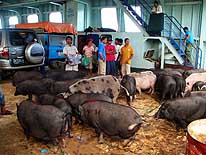
|
-
-
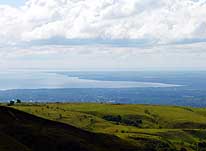
|
-
-
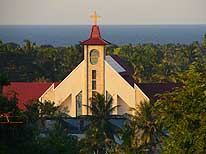
|
- 01
On our 8th Indonesian island
- hopping from Flores to Sumba, our
- LandCruiser is surrounded by
- 60 pigs during the 7 hour lasting trip.
- If this does not bring luck!
|
- 02
Waingapu – the capital – nestles
- between the sea and rolling hills
- covered with grass. After the
- previous tropical islands, it is a
- completely new feeling
|
- 03
The sight of churches, like this
- one in Waingapu, is common also on
- Sumba, despite that animal sacrifices
- are still widespread, to put their
- ancestors and spirits in a good mood
|
-
-
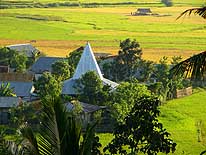
|
-
-
|
-
-
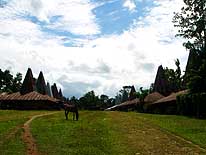
|
- 04
The modern corrugated iron roof
- of a traditional house rises above the
- rice fields in Waikabubak
|
- 05
Six people are buried in this grave
- in Kampung Pasunga in Anakalang,
- 22km East of Waikabubak. The vertical
- slab took six months to be carved with
- the figures of a man and a woman.
- During the construction, 150 buffaloes
- have been sacrificed
|
- 06
Kampung Pasunga with its
- corrugated iron roofs. A traditional
- Sumba village usually consists of
- two parallel rows of houses facing
- each other and a square in between
- with a spirit stone for offerings
|
-
-
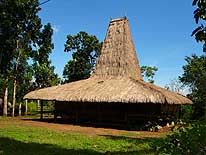
|
-
-
|
-
-
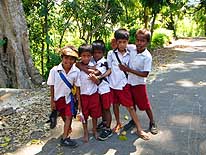
|
- 07
A traditional thatched house roof
- with a high gable, which slopes
- abruptly upwards from all four sides
|
- 08
One of the next candidates to
- be sacrificed? Besides water buffaloes
- pigs are the most sacrificed animals. A
- very big swine shall cost around US$600
|
- 09
School children are always
- ready to pose for a picture
|
-
-
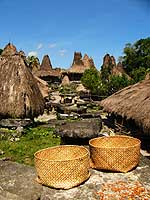
|
-
-
|
-
-
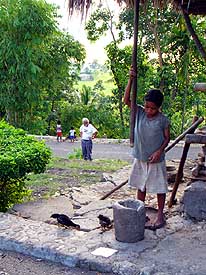
|
- 10
View of the traditional village of
- Tarung in Waikabubak. It is astonishing,
- how friendly people react when we
- walk trough their village, where life
- is taking place outside. They are
- not yet fed-up with tourists!
|
- 11
This old woman is sitting quietly
- on the “verandah” of her house in
- Tarung village. Her mouth is red
- from chewing betel nut
|
- 12
A daily task: Pounding rice
- in Tarung village (with Emil in
- the back). This traditional, modest
- life recalls memories of Africa
|
-
-
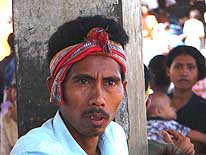
|
-
-
|
-
-
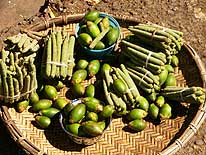
|
- 13
This man, wearing the traditional
- head dress, is waiting for the departure
- of his bus in Waikabubak
|
- 14
What a promising brand of cigarettes!
- In this part of the world, we hardly find
- someone who does not smoke. The name
- „Swiss“ or „Switzerland“ is used often
- everywhere, whether legally or illegally
|
- 15
The Betel Nut is sold in every market.
- In Sumba, this “stimulation” is still traditionally
- chewed (similar to Qat leaves in Yemen). The
- nuts and the green stalks are mixed with lime
- (which often is here extracted from corals).
- It creates a red mouth and a big amount
- of saliva, which is spit out constantly
|
-
-
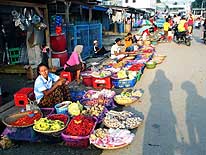
|
-
-
|
-
-
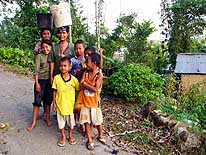
|
- 16
This colorful market takes
- place every day in Waikabubak
|
- 17
A Mitsubishi overland bus with its
- typical nose upwards is being loaded
- at the Waikabubak bus station
|
- 18
People love to pose for pictures.
- Here on the way back to their house
|
-
-
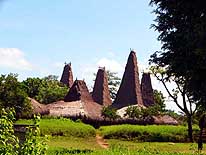
|
-
-
|
-
-
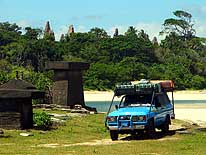
|
- 19
This group of thatched houses
- with its extreme high roofs belongs
- to the traditional village of Ratenggaro
- on the wild West Coast of Sumba
|
- 20
At the sea shore near Ratenggaro,
- locals are quick on the scene trying
- to sell handicrafts
|
- 21
Carved stone tombs and high
- roofs of the village of Wainyapu across
- the river add to the beautiful Western
- coast line at Ratenggaro
|
-
-
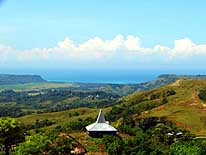
|
-
-
|
-
-
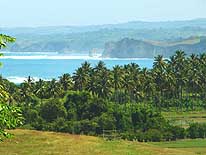
|
- 22
View over the rolling hills of
- Waikabubak towards Marosi
- Beach, situated in the South
|
- 23
The high roofs of a traditional
- village often peep out above the trees,
- as here on our way to Marosi Beach
- in the South of Waikabubak
|
- 24
View of the coast at Marosi
- Beach with its cliffs on one side .....
|
-
-

|
-
-
|
-
-

|
- 25
..... and its rice fields
- on the other side
|
- 26
Rice fields, palm trees
- and the sea at Marosi Beach
|
- 27
We can drive right to the beach
- at Marosi Beach, what is very rare
|
-
-

|
-
-
|
-
-
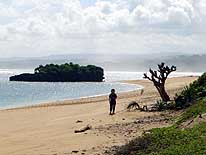
|
- 28
Marosi Beach – lonely,
- virgin, clean – simply beautiful
|
- 29
A herd of water buffaloes are on their
- way along the beach to the feeding grounds
|
- 30
At Marosi Beach: Liliana enjoys
- collecting beautiful shells
|
-
-
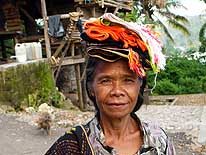
|
-
-
|
-
-
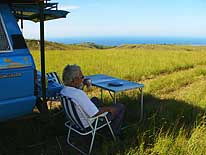
|
- 31
This 60 year old lady carries
- her “Ikats“ not only on her head,
- it’s also a kind of sun protection
|
- 32
A modest life in and with the nature
|
- 33
A last picnic on our way back to
- Waingapu, before boarding the ferry to
- Timor. Emil relaxes with a Bintang beer
|
-
-
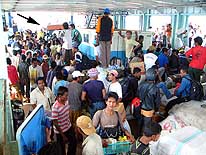
|
-
-
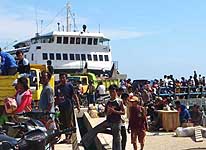
|
-
-
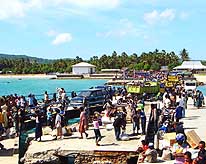
|
- 34
We wonder where on this ship
- we might find for two nights a place
- to sleep during the 36-hour trip from
- Sumba via Sabu to Kupang on
- West-Timor? It’s our 9th voyage
- on a ferry in Indonesia
|
- 35
A big crowd awaits the arrival
- of the ferry on our stopover on
- the island of Sawu (Sabu)
|
- 36
Palm trees, sandy beaches
- and the islanders greet us on Sawu
|
-
-
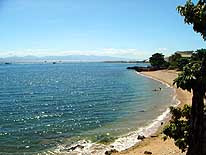
|
-
-
|
-
-
-
 -
|
- 37
We enjoy the fine sea view sipping
- a few cold Bintang beers at the
-
Lavalon-Bar in Kupang
|
- 38
This lady selling all kind of
- stuff for a better sexual life is
- never short of customers!
|
- 39
The street stalls in Kupang are
- well equipped with all kind of goods
|
-
-
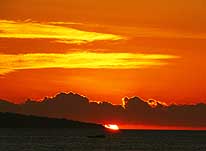
|
-
-
|
-
-
-
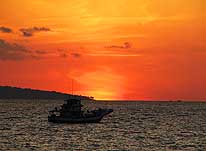 -
|
- 40
|
- 41
|
- 42
|
- Kupang, the main town of Western Timor, is a dusty, uninteresting place with about
200’000 people.
- But the sunsets are spectacular and different each day, as here on three days on a row
|
-
-

|
-
-
|
-
-
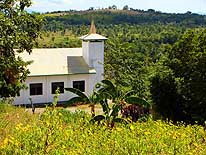
|
- 43
West Timor is drier than the
- other Indonesian islands we visited
- before and reminds us to the
- Australian Outback
|
- 44
The road from Kupang to Soe
- winds itself steadily towards the
- mountains to a height of 2’625 ft.
|
- 45
A meadow covered with golden
- daisies on our way to Soe awakens
- memories of „home“. It contrasts
- wonderfully against the white
- painted mountain church
|
-
-
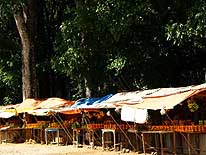
|
-
-
|
-
-
-
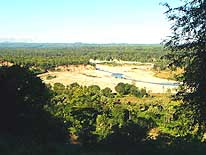 -
|
- 46
Before Soe, vegetables and fruits
- are sold along the road, especially sweet
- oranges. We buy four avocados for
- 5’000 Rupias =(50 US-Cents)
|
- 47
Between Soe and Kefamenanu,
- we cross a deep gorge .....
|
- 48
..... and enjoy a lovely view over a
- wide, nearly dry river bed from a hilltop
|
-
-
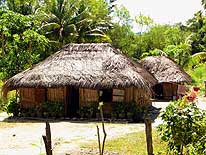
|
-
-
|
-
-
-
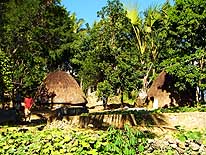 -
|
- 49
Around Soe, thatched roof
- houses pop up everywhere,
- here with plants adorning the front
|
- 50
We admire him in his
- traditional Sarong – and he
- admires us in our car
|
- 51
Unique for this West-Timor region
- are the beehive-shaped houses. With no
- windows and the entrance only a little more
- than 3 ft. high, they are small and smoky. The
- Indonesian authorities have started to replace
- them, but the locals do not like the new ones,
- because they are “cold and unhealthy”
|
-
-
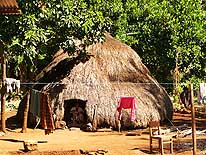
|
-
-
|
-
-
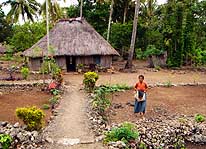
|
- 52
|
- 53
|
- 54
|
- Who does not think of Africa? Traditional villages with
thatched houses dot the way from Soe to Kefamenanu and Atambua
|
-
|
|
To:
Enclave of Oecussi in Timor-Leste
May 15th, to May 18th, 2007
< OR >
May 19th, to June 4th, 2007
To: Mainland of Timor-Leste
|
|
|
|
Continuation in Indonesia:
Pictures
from the fifth part of our Indonesian trip in Sulawesi from June 13, to July 14, 2007 |
|
|
- More websites from Indonesia and
Timor-Leste:
More websites from East Malaysia and
Brunei:
|
- Articles in newspapers about us in Indonesia:
- Article: "Tamu Istimewa: Neverending
Journey", Monthly Car Magazine "Jip", January 2007
- Article: "Toyota
FJ60 1982 World Travelers", Monthly Car Magazine "Jip", February
2007
- Article: "CHEESE
LAND CRUISER", Monthly Car Magazine "BBC Top Gear", February 2007
- Article: "22
Tahun Jelajahi 156 Negara", Daily Newspaper "Post
Metro Balikpapan", July 17, 2007
|
